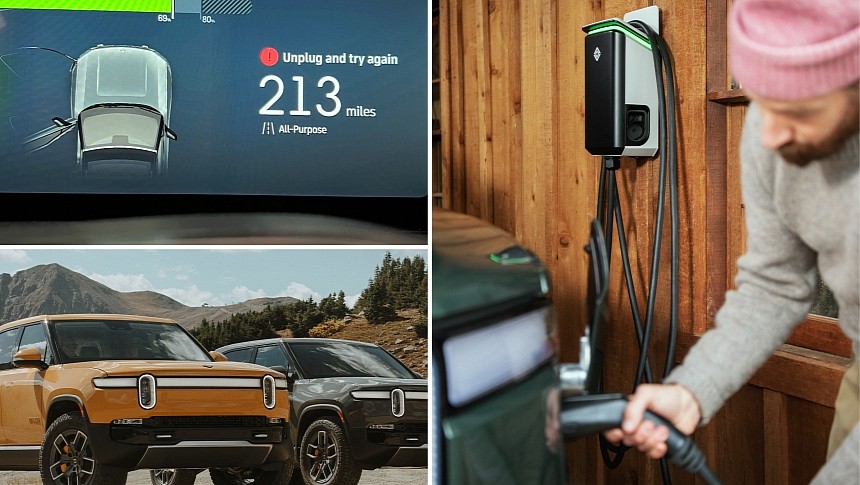Rivian R1T and R1S owners started complaining about not being able to charge their EVs at home or elsewhere using Level 1 and Level 2 chargers. Rivian clarified that the problem was caused by faulty onboard AC chargers and initiated a service campaign to replace the defective component.
One of the best parts of owning an electric vehicle is that you can charge it overnight at home or wherever you are. This way, you'll start the day with enough battery to get you through the day and never think about it. Of course, during longer road trips, you also have the alternative of charging your EV using a DC fast charger, which usually tops up the battery in half an hour or less. The downside is that it puts more strain on the battery, accelerating wear.
That's why everybody prefers slower overnight charging, also known as Level-1 (for a household 120-volt connection) and Level-2 charging (dedicated 240-volt connection). Both types of chargers use alternative current (AC), which allows easy conversion to the voltage the car needs (either 400 volts or 800 volts, although some use different voltages). Electric vehicles rely on an onboard AC charger to use the lower AC voltage. When the onboard charger goes bust, AC charging is impossible.
This is precisely what happened to some Rivian owners, who started complaining about not being able to use AC chargers at home or in parking lots. Most of them were clueless, blaming the charger or the adapter. Still, Rivian set things straight, admitting a problem with the onboard AC charger. The EV startup notified owners it would replace the faulty AC chargers free of charge during a customer satisfaction campaign.
Rivian explained that the problem was caused by a faulty component in the onboard chargers shipped by a third-party supplier. The affected models are R1S and R1T, built between December 2022 and March 2023. However, these are "approximative build dates," meaning that Rivian has no clue about how many vehicles are affected, let alone specific VINs. Rivian says the work needed to replace the faulty component doesn't require a visit to the Service Center and can be done via Mobile Service. You can read the attached service bulletin below the article.
The good news is that affected owners can still use DC fast chargers until their onboard AC chargers are replaced. This may be less practical and more expensive than charging at home, but it still offers a quick and easy way to charge your EV. Based on people's reactions on the RivianForums, the issue is limited, with few owners impacted. Some of them revealed that lowering the amperage for the onboard charger from the maximum 48 amps to 40 or even 32 amps can "convince" it to work, but your mileage may vary.
That's why everybody prefers slower overnight charging, also known as Level-1 (for a household 120-volt connection) and Level-2 charging (dedicated 240-volt connection). Both types of chargers use alternative current (AC), which allows easy conversion to the voltage the car needs (either 400 volts or 800 volts, although some use different voltages). Electric vehicles rely on an onboard AC charger to use the lower AC voltage. When the onboard charger goes bust, AC charging is impossible.
This is precisely what happened to some Rivian owners, who started complaining about not being able to use AC chargers at home or in parking lots. Most of them were clueless, blaming the charger or the adapter. Still, Rivian set things straight, admitting a problem with the onboard AC charger. The EV startup notified owners it would replace the faulty AC chargers free of charge during a customer satisfaction campaign.
Rivian explained that the problem was caused by a faulty component in the onboard chargers shipped by a third-party supplier. The affected models are R1S and R1T, built between December 2022 and March 2023. However, these are "approximative build dates," meaning that Rivian has no clue about how many vehicles are affected, let alone specific VINs. Rivian says the work needed to replace the faulty component doesn't require a visit to the Service Center and can be done via Mobile Service. You can read the attached service bulletin below the article.
The good news is that affected owners can still use DC fast chargers until their onboard AC chargers are replaced. This may be less practical and more expensive than charging at home, but it still offers a quick and easy way to charge your EV. Based on people's reactions on the RivianForums, the issue is limited, with few owners impacted. Some of them revealed that lowering the amperage for the onboard charger from the maximum 48 amps to 40 or even 32 amps can "convince" it to work, but your mileage may vary.






